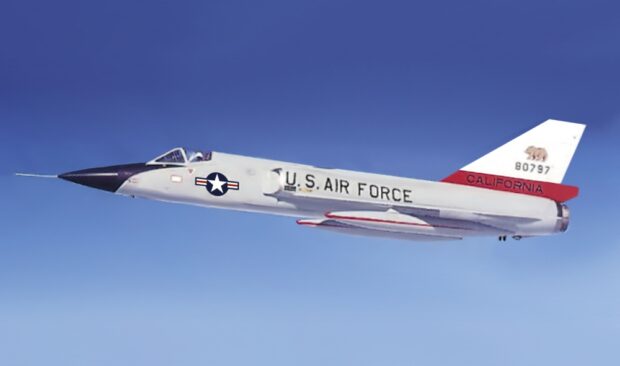The Convair F-106 Delta Dart was the main all-weather interceptor jet of the United States Air Force for almost 20 years. Designed from scratch as the so-called “Ultimate Interceptor,” pilots would reportedly fight each other to fly it.
It had one mission, and it had to be fast. With a sleek body and missiles tucked in an internal weapons bay, it could reach speeds over 1,500 miles-per-hour to intercept the Soviet Union’s long-range bombers.
And, as one bizarre incident would show… it could sometimes fly and land on its own.
The Convair F-106 Delta Dart was the primary all-weather interceptor aircraft of the United States Air Force from the 1960s through to the 1980s. Designed as the so-called “Ultimate Interceptor”, it proved to be the last specialist interceptor in U.S. Air Force service to date. It was gradually retired during the 1980s, with the QF-106 drone conversions of the aircraft being used until 1998 under the Pacer Six program.
The F-106 was the ultimate development of the USAF’s 1954 interceptor program of the early 1950s. The initial winner of this competition had been the F-102 Delta Dagger, but early versions of this aircraft had demonstrated extremely poor performance, limited to subsonic speeds and relatively low altitudes. During the testing program the F-102 underwent numerous changes to improve its performance, notably the application of the area rule to the fuselage shaping and a change of engine, and the dropping of the advanced MX-1179 fire control system and its replacement with a slightly upgraded version of the MX-1 already in use on subsonic designs. The resulting aircraft became the F-102A, and in spite of being considered barely suitable for its mission, the Air Force sent out a production contract in March 1954, with the first deliveries expected in the following year.
By December 1951 the Air Force had already turned its attention to a further improved version, the F-102B. Initially the main planned change was the replacement of the A-model’s Pratt & Whitney J57 (itself replacing the original J40) with the more powerful Bristol Olympus, produced under license as the Wright J67. By the time this would be available, the MX-1179 was expected to be available, and was selected as well. The result would be the “ultimate interceptor” the Air Force wanted originally. However, while initial work on the Olympus appeared to go well, by August 1953 Wright was already a full year behind schedule in development. Continued development did not resolve problems with the engine, and in early 1955 the Air Force approved the switch to the Pratt & Whitney J75.
The J75 was somewhat larger than the J57 in the F-102A, and had greater mass flow. This demanded changes to the inlets to allow more airflow, and this led to the further refinement of using a variable-geometry inlet duct to allow the intakes to be tuned to best performance across a wide range of supersonic speeds. This change also led to the ducts being somewhat shorter. The fuselage grew slightly longer, and was cleaned up and simplified in many ways. The wing was slightly enlarged in area, and a redesigned vertical tail surface was used. The engine’s 2-position afterburner exhaust nozzle was also used for idle thrust control. The nozzle was held open reducing idle thrust by 40% giving slower taxiing and less brake wear.
Production contract
A mock-up with the expected layout of the MX-1179, now known as the MA-1, was inspected and approved in December 1955. With growing confidence that the aircraft was now improving, an extended production contract for 17 F-102Bs was sent out on 18 April 1956. On 17 June, the aircraft was officially re-designated as the F-106A.
Prototype
The first prototype F-106, an aerodynamic test bed, flew on 26 December 1956 from Edwards Air Force Base, with the second, fitted with a fuller set of equipment, following 26 February 1957. Initial flight tests at the end of 1956 and beginning of 1957 were disappointing, with performance less than anticipated, while the engine and avionics proved unreliable. These problems, and the delays associated with them, nearly led to the abandoning of the program, but the Air Force decided to order 350 F-106s instead of the planned 1,000. After some minor redesign, the new aircraft, designated F-106A, were delivered to 15 fighter interceptor squadrons along with the F-106B two-seat combat-capable trainer variant, starting in October 1959.
World Speed record
F-106A Delta Darts from 5 FIS at CFB Moose Jaw in 1982
On 15 December 1959, Major Joseph W. Rogers set a world speed record of 1,525.96 mph (2,455.79 km/h) in a Delta Dart at 40,500 ft (12,300 m).
That year, Charles E. Myers flew the same model aircraft at 1,544 mph (2,484 km/h).
Sources; YouTube; Wikipedia

